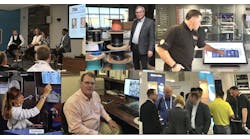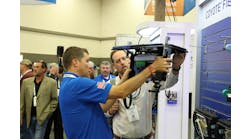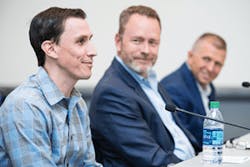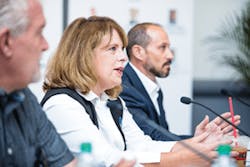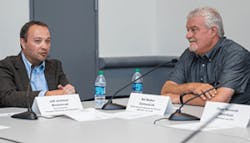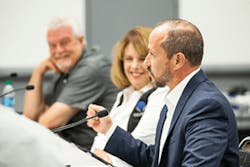Latest from Professional Development/Leadership
ICT Visionaries 2018 Roundtable Highlights
Live Event at ISE EXPO 2018 —
Each year, the ICT Visionaries gather at ISE EXPO to share their perspectives about challenges facing service providers and ways the vendor community can help solve them. Below are some brief highlights of the many questions they discussed so you can get a feel for the breadth and depth of the discussion.
Christopher Sigley, Frontier Communications, Mike Grice, Amphenol Broadband Solutions, and Andrew Buchert, TDS Telecom, find common ground while discussing the budgetary and policy challenges facing service providers today.
But, if you really want the inside scoop, throw your name in the hat to be considered for a coveted spot in the 2019 ICT Visionaries program. Or, nominate one of your respected colleagues. (Email: [email protected])
STRATEGIC CHANGE
ISE: What are the challenges of designing and implementing strategic change in an industry such as ours? How do we prepare our networks, equipment, and PEOPLE, to be ready for the changes ahead?
Cheri Beranek, Clearfield: The biggest issue is people rather than the technology. Because technology,
by definition, is going to change at a very rapid pace. (That’s likely why most of us joined the industry.) The standpoint I’ve embraced for the last 20 years and that which we embrace within our organization is simple: hire people who are smart, who are willing to work hard, and the rest of it will take care of itself.
Mike Grice, Amphenol, Broadband Solutions: I definitely agree with the people part. The other thing Jeff and I were talking about is the way you look at this technology roll out. If you have a large asset base you try to determine where’s your entry point when you invest in X. Is there a migration path? Am I looking for that reverse compatibility? Am I going to get the big things coming out now? Or, am I just flipping the whole thing over in the interest of doing it once and plowing it under, so I don’t have to do it again?
Cheri Beranek, Clearfield, proposes that vendors and providers must use agile methods with TCO in mind to make fiber-to-the-business profitable, so it can help fund FTTH and MDU fiber deployments.
Indeed, there’s rapid change in technology and even a rapid change in philosophy about how the network comes together. That’s why it can be fairly daunting to try and determine the best strategy.
Jeff Jockman, Windstream: I think the industry is fairly well-aligned from a technology perspective and we’re all well-practiced with technology changes.
I think the hard part is the people because we’ve developed through silos. There’s a transport silo, a data silo, a voice silo, and each silo is trying to optimize its own piece of the pie. But the whole silo strategy starts breaking down when there are people who are good with hardware protocols or data and programming, but they know little about both hardware AND software. To move forward you need flexible personnel who are good on both the hardware and on the protocol and software sides. If we can’t get there we’re stuck.
Andrew Buchert, TDS Telecom: I want to echo what others addressed about the people side of our business. Clearly, technology changes keep moving faster and faster. When I look at my kids, who are in their twenties, they just cycle through different technologies without even thinking about it.
Jeff Jockman, Windstream, and Bill Walker, CenturyLink, discuss their passions related to customer behavior and automation as a way to empower the network holistically.
In our business, this pace is not native to most folks. The challenge is figuring out how to have them participate in the rapid change while also leveraging their experiences.
Jeff Jockman, Windstream: We can’t sacrifice the legacy base either. Everyone is focused on the go-forward technology and we’re really good at layering new technology over old. But, what about retiring the old technology?
Bill Walker, CenturyLink: You’ve made some really good points. But, it’s not just people and skills, it’s behaviors. I can go hire a bunch of smart people who will understand data and networks. But how do they interact with each other and actually work together? That’s what is changing. Breaking out of the silo and then hiring people who have the right behaviors to move forward productively.
This year, we hired some interns for one semester and they expected to build something. We work with the graduate program at Colorado University, Boulder, especially around their CapStone projects. One set of grad students figured out how to punch a hole through a mountain and lay fiber to a ski slope. Then, they put wireless on top of one of the ski lifts and beamed it down into an underserved town. All of this was part of their school project.
When they proposed it, I thought 4 college kids can’t do this. But, they called the State and determined that Colorado had funds that they could use if we brought fiber to the ski slope, and Internet to a rural community. The interns made these backdoor deals to get Internet extended to this town. Then, they found an ISP to run it and give them backhaul to the ski slopes. Today the town has Metro Wi-Fi. The ski resort loves it because they got fiber in exchange for putting a little millimeter wave on the top of the tower. All of this from some amazing college kids from the CU grad programs. After watching that, I knew I wanted that kind of behavior inside CenturyLink.
Andrew Buchert, TDS Telecom: We also have our intern program and it’s amazing to watch. Not just for the talent that it’s bringing in, but what it is doing culturally.
Bob Whitman, Corning Optical Communications, connects with the entire group as he advocates for the industry coming together to help solve the many challenges related to 5G after initial trials.
Jeff Jockman, Windstream: Everyone is trying to keep up! These people who are fresh out of college, or a year out of college, are extremely passionate about what they do. That has a lot to do with their culture. Compare this to employees who have been forced to work inside the box for their whole careers. Now they see a cultural shift where they are actually encouraged to think outside the lines! That is a dramatic shift in the legacy culture — and a good one!
Chris Walker, ESPi: All of these points are valid. Interestingly, the stories you tell are similar to years ago when I started in telecommunications with a very small independent in the middle of Oklahoma. I was that guy coming in from the outside, not as an intern, but certainly the new guy coming into a legacy culture. This was in the days of the really large DMS 100 and 200 switches. When I started, they gave me one little tiny rack which handled the entire Internet for the Oklahoma panhandle. So, in this big CO, I’ve got 1 rack. And what I thought was interesting was that none of those guys really cared about the Internet thing. I would be curious what they are thinking about it now. In a nutshell, what you describe isn’t a new problem. It’s just that’s one more thing that’s been going wrong for a while.
MY TAKE
ISE: Share one problem or challenge in the ICT industry that you are passionate about solving.
Chris Wacker, ESPi: It’s been interesting talking about the challenges with fiber and getting it out there. One of my passions is how do we provide power at that remote sealed access node that doesn’t have any utility power running to it?
Waiting 90 days or more to add utility power to remote locations is a tremendous bottleneck to deploying services. Our new Voltar-Plus product solves that problem and is now the most popular product we have in our portfolio. Some of them leave it in place to eliminate the generators while others are using it for immediate 48V power during an emergency. It’s less costly than rolling trucks to fill up generators.
Recently, I was meeting with one provider in Wisconsin and I said it was approximately $20,000 to set a utility meter at a remote site. The guys at Frontier stopped me and said, "You’re off." I asked, "How far off was I?" They shared that it was $125,000 and they had 3 sites they wanted turned up right away. I shared that we have sustainable solutions that can absolutely fix that problem. That conversation speaks to how open minds can create new solutions to old problems.
InvisiLight® Solution for Deploying Fiber
April 2, 2022Go to Market Faster. Speed up Network Deployment
April 2, 2022Episode 10: Fiber Optic Closure Specs Explained…
April 1, 2022Food for Thought from Our 2022 ICT Visionaries
April 1, 2022Mike Grice, Amphenol Broadband Solutions: I’m intrigued about this network evolution thing and looking at what things we can do to move the needle. I think one of the things we’re going to see with upcoming apps that bring consumers and businesses so much value is managing data that’s never been seen before. It’s correlating things that have never been correlated before. So, you start looking at large data sets and you need to have predictive capability.
You start to address people in a way that’s really personal. And in some ways that’s cool. For example, think of how a music app knows my music preference and then suggests other music that aligns with my previous "likes". Taking it one step further, consider how my calendar app (via Apple or Google or whoever) knows exactly where I was last Tuesday. It also knows who my contacts are, even if I don’t want Apple or Google to have that information.
We’ve already seen a bit of backlash from the really big players, like the Apples and the Googles. I think we will start to see a potential backlash against giving up our privacy. Each of us will have to figure out what we do with that, because all of us have different comfort levels of our privacy or lack of it.
So, in our industry, we must keep delivering more and more, but we also need to be prepared for a potential backlash when we step a little bit too far into our customers’ personal data.
On the flip side, I’ve seen some service providers offer to give customers a better rate IF they allow the provider to know and share some of their private data. For the first time, I saw providers put a dollar amount on customers’ private data. While others choose to market that they respect their customers’ privacy and won’t ask them to sell-out just by offering a better price by allowing them to mine your data. It’s all very interesting.
Behind closed doors, providers and vendors are candid with each other about what needs to happen across the ICT industry to transform the network in a cost-effective manner while remaining relevant to end users.
Jeff Jockman, Windstream: I think automation is really critical to our industry. We need automation not just for the sake of reducing head count. We need it for the sake of efficiency. It enables new services, it enables better customer experience, it enables faster time to market. There are so many benefits to it.
Thinking back to one of my really early jobs, I was doing transport tests and turnout on old Nortel, SDMS, and OC192. One of the first things I realized was how long it took to provision the NEs to configure all the custom performance monitoring stats that were on a per cord basis on these devices. Soon after, I sat down after hours and started building Procom scripts to automate the test and turn up function and to automate the printing function. The first was a very simple one node. Then it expanded to where it would walk its way up and down the span, detect what hardware was in the device and provision it factually, based off the parameters it was given.
I wasn’t hired to build that automated tool. I wasn’t tasked with building an automated tool. But a huge benefit was created from having an automated tool. So, I created it. It turned a 1-hour job into a 5-minute job.
There is a lot of benefit, direct and indirect, to be had from automation. The fact that we are finally pivoting well to software-centric networks and breaking down the silos between the transport and the Layer 2 and the Layer 3, which means we are finally looking at networks as a holistic entity. I’m very passionate about automation; there’s a lot to be gained from it.
Cheri Beranek, Clearfield: I’m passionate about the total cost of ownership perspective. We must remember that we are for-profit companies and it’s OK to make a profit and to be proud of making a profit. It’s important to promote that this is about success-based deployments. And while we’re moving forward, we need to do it in an agile fashion, rather than looking at it as this big, behemoth problem that we don’t know how to solve. Agile methodology says you break a project or task into smaller parts, and to champion and celebrate the smaller parts in the overall success.
It’s the kind of thing we see now with the concept of building (fiber) to-the-business, because the business enterprise is what is going to fund the mechanism to enable you to pass all those homes with the business class services. Or, if you’re passing all those homes with edged computing and the towers servicing 5G. That’s what’s making the money. Fiber-to-the-home and the MDUs will follow behind it, so it’s not an either/or option. It’s just a holistic possibility to create reasonable alternatives.
Andrew Buchert, TDS Telecom: Though I’m passionate about and in agreement with all of these topics, I’m going to take a different approach. It’s from an operations perspective. You see, I have responsibility for our technicians who are out in the field, splicing and connectorizing things. I have a concern that there’s a shortage right now of individuals who want and will participate in those jobs.
We serve a lot of rural areas, and we’re having more and more struggles in finding people to do those jobs on an hourly basis. In addition, we have employees retiring. So, it’s becoming more and more critical to look at that. We talk about the great things we can do for our engineering interns. But, we have a society of young people who’ve grown up with a screen in front of them and they’re not interested in doing the type of hourly work we have to offer in the technician area.
It’s not just a telecom thing, it’s an issue affecting across many of the trades. The reality is it’s getting harder and harder to secure good talent. We are all facing it. Even with all this great automation to fix things when they break or before they break, in most instances, there will still need to be a touch point in the field.
Bill Walker, CenturyLink: And the more rural you get the more you lose your pooling capability. So, if I’m in the middle of nowhere Minnesota, who do I get to climb that pole? Who do I get to go open the door to that CO? Clearly, I have a workforce that’s not pooled around the urban areas, but I still have to maintain coverage for whatever SLA and response time I have in Stinson, Wyoming.
Bob Whitman, Corning: My passion is related to 5G. From my vantage point, it looks like fiber did 17 years ago. Back then, we saw the industry fragmenting. We had copper versus fiber. And the first standard bodies were EPON and GPON. The bottom line was that we were facing all of these challenges, yet there wasn’t any place to help the industry in an agnostic fashion. So, we started the Fiber-to-the-Home Council. Its goal was to help the industry put differences aside and build the industry up. It was not about standardizing. Instead, it was about getting a common message out and a commitment to educating and growing the industry.
Now, we’re starting to see 5G trials and a lot of people are making equipment and a lot of providers are trying it out. Yet, there’s not a group of people that are banding together to figure out how to make everything work together. As an industry, let’s solve the cost problems. Let’s solve the regulatory problems — together. Sure, there are splintered groups who are working on small parts of 5G. But, what I am passionate about is that it’s time for the industry to get together and help solve the many challenges that are going to be seen after the initial trials go through.
Rob Lombard, Norvado: My passion involves accomplishing customer-originated automation that can deliver 24/7. For years, we’ve tried to provide the customer with the simple ability to increase the speed of their Internet at 11:00 p.m., for example. We are seeing a lot of problems where customers don’t know if their lack of speed is due to their Wi-Fi, or if their computer has a virus, or if it’s simply not enough speed from their Internet service.
Why can’t we create a "go-faster" button that can jump the customer’s Internet speed up 2-speed tiers for a short period of time? So, if that fixes the customer’s problem, then great, they order the new speed. If it doesn’t, he or she can click on another button and order a new Wi-Fi Router and it gets shipped out right away, or they can choose to have a tech come install it and be able to schedule based a convenient time for them and the tech.
Bill Walker, CenturyLink: My passion relates to customer behavior. Think back to when the iPhone came out in New York and New York kind of went dead for a while, until the network caught up. I’m terrified that at some point in the very near future there will be a Killer App that will severely impact the network.
That’s not the case today, as even our heavy-hitter using homes are only at 2 or 3 megabits on a 24/7 normalized basis. But, in the future, 4kTV sucks down about 4-4.5 Mbps. If I’ve got a high-tech house with 3 new 4kTV’s, they’re maybe using 14 Mbps, triple the previous trend. So, for argument sake, let’s say there’s a steady trend of 15% YoY increase in traffic, these technology Killer Apps create unplanned demand on our network.
What happens when there is some app for fixed and wireless that demands not necessarily the bandwidth, but also the latency and the security? I think of when my kids are playing Pokémon Go. Wouldn’t it be really cool if that was augmented reality and you could have the background work? But, then Nintendo knows where my kids are. My 8-year-old son is now sharing his location and his age and his sex and who knows what else.
Then, what if this Killer App demands latency, jitter, and throughput, but also opens a bunch of privacy doors? Clearly, that’s going to impact the network, so that’s my professional concern. But, being a parent, it scares the tar out of me that my kids could be giving away their GPS location and personal details.

Sharon Vollman | Content Ambassador for ISE EXPO
Sharon Vollman is the Content Ambassador for ISE EXPO. She is passionate about collaborating with thought leaders, SMEs and hard-working doers who design, plan and deploy ultra-reliable broadband networks. Vollman is committed to creating a variety of educational offerings for ISE EXPO attendees that inspire them to connect every U.S. citizen with the broadband networks we all want for our children and grandchildren.
Vollman has created educational partnerships with Broadband Service Providers including AT&T, Verizon, Lumen, Frontier Communications and others. She has covered the telecom industry since 1996.
